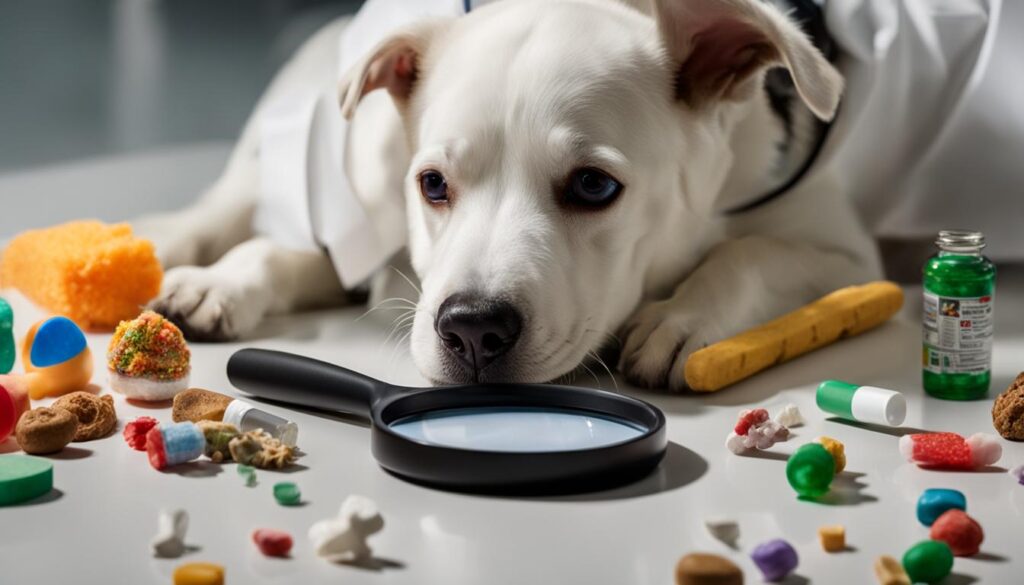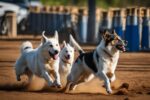Understanding and Reducing Excessive Licking in Dogs

Dogs are known for their affectionate nature and unique behaviors. However, excessive licking in dogs can be a cause for concern. It may indicate underlying health issues or behavior problems that require attention and intervention. In this article, we will explore the reasons behind excessive licking in dogs, how to investigate the behavior, and ways to address it effectively.
Excessive licking can stem from various causes, including injury, nausea, itchy skin, dental disease, neurologic problems, cognitive dysfunction, and obsessive-compulsive disorders. It can also be a manifestation of stress, anxiety, separation, or boredom. Identifying the underlying cause is crucial to addressing the issue and providing appropriate treatment.
During our discussion, we will delve into potential medical and behavioral causes of excessive licking, as well as the symptoms to watch out for. We will also explore the different meanings behind dog licking, including affection, grooming, seeking attention, empathy, and taste.
If you suspect that your dog is excessively licking, it is important to consult with a veterinarian for a proper diagnosis and treatment plan. They can recommend strategies such as dietary changes, flea treatment, allergy medication, behavior modification, and even medication to reduce anxiety. Addressing excessive licking in dogs not only improves their well-being but also promotes a harmonious relationship between dogs and their owners.
Next up: In the following section, we will dive deeper into the various reasons behind excessive licking in dogs, including injuries, medical conditions, and behavioral factors. Stay tuned to learn more about how best to understand and address this behavior.
Reasons for Excessive Licking in Dogs
Dogs may lick excessively due to various reasons. Understanding the underlying causes of excessive licking behavior in dogs is essential for providing appropriate care and treatment. Here are some common reasons why dogs may lick excessively:
Injury
- Thorns or burrs stuck between the pads of their feet
- Lacerations under thick coats
Nausea
Nausea can lead to excessive salivation and licking in dogs. If your dog is experiencing frequent bouts of licking accompanied by signs of discomfort, it’s important to consult a veterinarian to rule out any underlying medical issues.
Hunger or Dehydration
When a dog is hungry or dehydrated, they may lick excessively as a way to communicate their needs. Ensuring regular mealtimes and access to clean, fresh water can help reduce this behavior.
Itchy Skin
Itchy skin is a common cause of excessive licking in dogs. If your dog is constantly scratching, chewing, or shaking their head, it may be a sign of allergies or skin conditions. A veterinarian can provide a proper diagnosis and recommend appropriate treatment options.
Dental Disease
Dogs with dental disease may exhibit excessive licking behavior. Bad breath, changes in eating habits, and visible signs of dental issues should be addressed by a veterinarian to prevent further discomfort or complications.
Neurologic Problems
Neurologic problems, such as seizures, can manifest as excessive chewing or licking in dogs. If your dog shows signs of chewing gum fits or tremors, it’s important to consult a veterinarian for proper diagnosis and management.
Cognitive Dysfunction
Older dogs with cognitive dysfunction may experience tremors and exhibit excessive licking behavior. Providing a comfortable environment and seeking guidance from a veterinarian can help manage this condition.
Obsessive-Compulsive Disorders
Psychological disorders, including stress, anxiety, separation, and boredom, can contribute to excessive licking behavior in dogs. Identifying and addressing the underlying emotional needs of the dog can help reduce this behavior.
Understanding the reasons behind excessive licking in dogs can guide appropriate treatment and management strategies, ensuring the well-being of our beloved furry companions.
Investigating Excessive Licking Behavior in Dogs
Understanding the reasons behind excessive licking behavior in dogs can be challenging as they cannot directly communicate their needs or discomfort. Caregivers play a crucial role in investigating and observing the patterns and triggers of this behavior.
Observations
By carefully observing your dog’s licking behavior, you can gather valuable information that may help pinpoint the underlying cause. Note when the licking behavior started, when it occurs, the duration of each episode, and whether it can be easily distracted or stopped. These observations can provide important clues for understanding the triggers or associations related to excessive licking.

Changes in Environment or Routine
Changes in your dog’s environment or routine can contribute to excessive licking. Consider any recent changes such as the addition of a new housemate, a new pet, or alterations in the daily routine. Dogs are creatures of habit, and disruptions or stressors can manifest in excessive licking behavior. Keeping a record of any significant changes in your dog’s surroundings will help you identify potential triggers.
Thorough Communication with a Veterinarian
Consulting a veterinarian is vital in determining the underlying cause of excessive licking behavior. Your veterinarian will assess your dog’s overall health, conduct a physical examination, and potentially order additional diagnostic tests. By sharing your observations and any notable changes in your dog’s environment or routine, you can help the veterinarian form a comprehensive understanding of the situation and guide the investigation process.
Investigating excessive licking behavior in dogs requires keen observations, careful documentation, and thorough communication with a veterinarian. Identifying the underlying cause is crucial for developing an appropriate treatment plan and providing relief for your furry companion.
Understanding the Various Meanings of Dog Licking
Dogs have a unique way of communicating their feelings through licking. While it may seem like a simple behavior, dog licking holds various meanings and serves different purposes. Let’s explore the different reasons why dogs lick and what these actions signify:
Affection and Bonding
Dogs often lick their owners and family members as a display of affection. It is their way of demonstrating love and deepening the bond between them. When a dog licks your face or hands, it is a sign of trust and a desire for closeness.
Grooming and Cleaning
Licking also serves as a grooming behavior for dogs. They learn this behavior from their mothers during the early stages of life. Licking themselves and others helps them maintain cleanliness and hygiene. It is their natural instinct to keep their fur clean and free from dirt and debris.
Seeking Attention
Dogs may lick their owners as a way of seeking attention. It is their way of saying, “Hey, notice me!” By licking, they try to grab your attention and engage you in their world. This behavior can be particularly common if they feel ignored or lonely.
Expressing Empathy
Dogs possess a remarkable sense of empathy. When they see their owners upset or distressed, they may show their empathy by licking them. It is their way of comforting and offering support during times of emotional distress.
Exploring Taste
Another reason why dogs lick is to explore the taste of different objects. Dogs have a keen sense of taste, and licking helps them gather information about their environment. Whether it’s tasting food, investigating unfamiliar objects, or simply enjoying the flavors they encounter, licking allows dogs to satisfy their curiosity.
Licking is a natural behavior for dogs and serves various purposes. It is essential to understand that not all licking behavior is excessive or problematic. Dogs use licking as a form of communication and as a way to fulfill their natural instincts. However, if you notice excessive licking that is causing discomfort or harming your dog’s well-being, it is important to consult with a veterinarian for further evaluation and guidance in managing the behavior.
Causes and Symptoms of Excessive Licking in Dogs
Excessive licking in dogs can be a sign of underlying issues or discomfort. It is important for dog owners to identify the causes and understand the symptoms associated with this behavior. The following table highlights common causes and symptoms of excessive licking:
| Causes | Symptoms |
|---|---|
| Infections | Skin redness, discharge |
| Skin conditions | Hair loss, redness, skin lesions |
| Parasites | Itching, skin irritation |
| Allergies | Redness, hair loss, itching |
| Pain | Limping, sensitivity, discomfort |
| Anxiety | Restlessness, excessive grooming |
If your dog exhibits excessive licking along with any of these symptoms, it is crucial to consult a veterinarian for a proper diagnosis and treatment plan. Remember, early detection and intervention can help alleviate any discomfort or health issues your furry friend may be experiencing.
Next, we’ll explore the medical causes of excessive licking in dogs and how to address them.
Medical Causes of Excessive Licking in Dogs
Dogs may engage in excessive licking due to various medical conditions. These underlying issues can cause discomfort and urge dogs to excessively lick themselves. It is crucial to identify and address these medical causes to provide appropriate treatment and relief for our furry friends.
Infections
Infections, such as yeast, bacterial, or fungal infections, can lead to itchiness and inflammation, triggering excessive licking. Dogs with these infections may lick the affected areas in an attempt to alleviate discomfort and irritation.
Allergies
Allergies, including food allergies and environmental allergies, can contribute to excessive licking in dogs. When dogs are exposed to allergens, their immune system reacts, resulting in itchiness and skin irritation. Excessive licking is a common response to alleviate these allergy-related symptoms.
Pain
Pain, whether caused by arthritis, wounds, or other injuries, can lead to localized licking in dogs. Licking these painful areas is a natural instinct for dogs as they attempt to provide self-soothing and pain relief.

Properly diagnosing the underlying medical causes of excessive licking is essential. A veterinarian will be able to assess the symptoms, perform necessary tests, and recommend appropriate treatment options.
Diagnostics may include skin scrapings, blood tests, or allergy testing to identify any underlying infections or allergies. Treatment options can vary based on the specific condition and may include medications, dietary changes, or allergy management techniques.
By addressing the medical causes of excessive licking, we can help our beloved dogs find relief from discomfort and improve their overall well-being.
Behavioral Causes of Excessive Licking in Dogs
Excessive licking in dogs can sometimes be a result of underlying behavioral issues. Dogs may resort to licking as a way to calm themselves down or seek attention from their owners. Two common behavioral causes of excessive licking are anxiety and boredom.
Anxiety
Anxiety-related licking in dogs can be a manifestation of stress or fear. Dogs may continuously lick themselves or objects as a coping mechanism. Fortunately, there are over-the-counter solutions available to help manage anxiety in dogs, such as the Thundershirt.
The Thundershirt is a specially designed garment that applies gentle, constant pressure to a dog’s body, helping to calm their nerves. This pressure has a soothing effect, similar to the comfort an infant feels when swaddled. Many dog owners have reported significant improvements in their dogs’ anxiety-related licking behaviors after using the Thundershirt.
Boredom
Dogs require mental stimulation and engagement to prevent boredom, which can also lead to excessive licking. When dogs lack mental stimulation, they may resort to repetitive behaviors like licking to occupy themselves.
Providing mental stimulation for your dog is crucial in reducing excessive licking due to boredom. Engage your dog in activities that challenge their minds, such as puzzle toys or treat-dispensing toys. Regular training sessions can also provide mental stimulation and distract your dog from excessive licking.
Redirecting Excessive Licking Behavior
To redirect excessive licking behavior, it’s essential to address the underlying causes of anxiety or boredom. Along with using tools like the Thundershirt, establishing a routine of mental and physical stimulation can be highly beneficial.
Here are some strategies to redirect excessive licking behavior:
- Engage your dog in regular exercise to burn off excess energy.
- Provide interactive toys that require problem-solving skills.
- Implement obedience training sessions to keep their minds occupied.
By addressing the behavioral causes of excessive licking and providing appropriate outlets for their energy, you can help your dog overcome this behavior and improve their overall well-being.
Conclusion
Excessive licking in dogs can be a distressing behavior for both the dog and their owners. It is crucial to understand the underlying causes and address them appropriately to manage this behavior. Veterinary consultation is highly recommended to properly diagnose the cause of the licking and determine the most effective treatment plan.
Through a comprehensive veterinary examination, potential medical causes such as infections, allergies, or pain can be identified and treated. In addition, behavioral issues like anxiety or boredom can be addressed through behavior modification techniques and providing mental and physical stimulation.
Management of excessive licking may involve medication, dietary changes, allergy management, and environmental modifications. It is important to tailor the treatment plan to the specific needs of each dog, considering their health, lifestyle, and individual behavior patterns. With proper understanding and management, owners can help their dogs find relief from excessive licking and improve their overall well-being.
FAQ
What are the reasons for excessive licking in dogs?
Excessive licking in dogs can be caused by various factors, including injury, nausea, hunger or dehydration, itchy skin, dental disease, neurologic problems, cognitive dysfunction, and obsessive-compulsive disorders.
How can I investigate excessive licking behavior in my dog?
To investigate excessive licking behavior in dogs, it is important to observe when the licking behavior started, when it occurs, how long it lasts, and if it can be easily stopped or distracted. Changes in the dog’s environment or routine should also be noted.
What are the various meanings of dog licking?
Dogs may lick for various reasons, including showing affection, grooming, seeking attention, expressing empathy, and enjoying the taste. It is a natural behavior for dogs and an instinctive way for them to bond with their owners.
What are the causes and symptoms of excessive licking in dogs?
Excessive licking in dogs can be caused by various issues, such as infections, skin conditions, parasites, allergies, pain, and anxiety. Symptoms may include hair loss, redness, skin lesions, discharge, or limping.
What are the medical causes of excessive licking in dogs?
Medical causes of excessive licking in dogs can include infections (yeast, bacterial, or fungal), skin conditions, parasites, allergies (food and environmental), and pain (such as arthritis or wounds).
What are the behavioral causes of excessive licking in dogs?
Behavioral causes of excessive licking in dogs can include anxiety and boredom. Dogs may lick to soothe themselves or seek attention. Managing anxiety can be done with therapies like the Thundershirt, while addressing boredom can involve providing mental stimulation and regular exercise.
How can I manage excessive licking in dogs?
Understanding the underlying cause of excessive licking is essential in managing the behavior. Veterinary consultation is recommended to diagnose and treat the cause. Treatment options may include medication, dietary changes, allergy management, behavior modification, and providing mental and physical stimulation.
Source Links
- https://oakbrookanimalhospital.com/why-your-dog-is-licking-and-what-to-do-about-it/
- https://www.thekennelclub.org.uk/health-and-dog-care/health/health-and-care/a-z-of-health-and-care-issues/why-does-my-dog-lick-me-so-much/
- https://www.petmd.com/dog/general-health/excessive-licking-chewing-and-grooming-dogs






